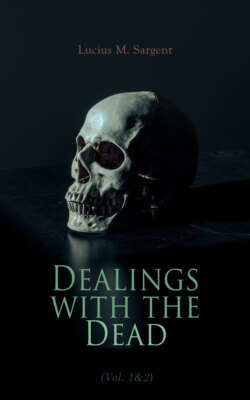Читать книгу Dealings with the Dead (Vol. 1&2) - Lucius M. Sargent - Страница 8
На сайте Литреса книга снята с продажи.
No. III.
ОглавлениеTable of Contents
The board of sextons have met, and we have concluded not to recommend a revival of the ancient custom of burning the dead. It would be very troublesome to do it, out of town, and inconvenient in the city. I have always thought it wrong to bury in the city; and it would be much worse to burn there. The first law of the tenth table of the Romans is in these words—“Let no dead body be interred or burnt within the city.” Something may be got to help pay for a church, by selling tombs below. When a church was built here, some years ago, an eminent physician, one of the proprietors, was consulted and gave his sanction. Yet more than one of our board is very sure, that, on a warm, close Sunday, in the spring, he has snuffed up something that wasn’t particularly orthodox, in that church. The old Romans were very careful of the rights of their fellows, in this respect: the twelfth law of the tenth table runs thus—“Let no sepulchre be built, or funeral pile raised within sixty feet of any house, without the consent of the owner of that house.” They certainly conducted matters with great propriety, avoiding extravagance and intemperance, as appears by the seventh law of the same table—“Let no slaves be embalmed; let there be no drinking round a dead body; nor any perfumed liquors be poured upon it.” So also the second law—“Let all costliness and excessive waitings be banished from funerals.” The women were so very troublesome upon these occasions, that a special law, the fifth, was made for their government—“Let not the women tear their faces, or disfigure themselves, or make hideous outcries.”
It was not unusual for one person to have several funerals: to prevent this, however agreeable to the Roman undertakers, the tenth law of the tenth table was made—“Let no man have more than one funeral, or more than one bed put under him.” There was also a very strange practice during the first Decemvirate; the friends often abstracted a finger of the deceased, or some part of the body, and performed fresh obsequies, in some other place; erecting there a cenotaph or empty sepulchre, in which they fancied the ghost of the departed took occasional refuge, when wandering about—in case of a sudden shower, perhaps; or being caught out too near daylight.
For the correction of this folly, the Decemvirs passed the sixth law of the tenth table—“Let not any part of a dead body be carried away, in order to perform other obsequies for the deceased, unless he died in war, or out of his own country.” It was upon such occasions as these, in which an empty form was observed, and no actual inhumation took place, that the practice of throwing three handsful of earth originated. This usage was practised also by the Jews, and has come down to modern times. Baron Rothschild (Nathan Meyer) who died in Frankfort, July 28, 1836, was buried in the ground of the Synagogue, in Duke’s Place, London. His sons, Lionel, Anthony, Nathaniel, and Meyer, his brother-in-law, Mr. Montefiore, and his ancient friend, Mr. Samuels, at the age of ninety-six, commenced the service of filling up the grave—by casting in, each one of them, three handsful of earth. Not satisfied with carrying a bottle of sal volatile to funerals, the women, and even the men, were in the habit of carrying pots of essences, which occasioned the enactment of the eighth law—“Let no crowns, festoons, perfuming pots, or any kind of perfume be carried to funerals.”
Burning or interring was adopted, by the ancients, at the will of the relatives. This is manifest from the eleventh law, which prohibits the use of gold in all obsequies, with a single exception—“Let no gold be used in any obsequies, unless the jaw of the deceased has been tied up with a gold thread. In that case the corpse may be interred or burnt, with the gold thread.” A large quantity of silver is annually buried with the dead. It finds its way up again, however, in the course of time.
Common as burning was, among the ancients, it was looked upon, by some, with great abhorrence. The body to be burned was placed upon a pile—if the body of a person of quality, one or more slaves or captives were burned with it. When not forbidden, all sorts of precious ointments and perfumes were poured upon the corpse. The favorite dogs and horses of the defunct were cast upon the pile. Homer tells us, that four horses, two dogs, and twelve Trojan captives were burnt upon the pile, with the dead body of Patroclus. The corpses, that they might consume the sooner, were covered with the fat of beasts. Some near relative lighted the pile, uttering prayers to Boreas and Zephyrus to increase the flame. The relatives stood around, calling on the deceased, and pouring on libations of wine, with which they finally extinguished the flames, when the pile was well burnt down. They then collected the bones and ashes. How they were ever able to discriminate between men, dogs, and horses, it is hard to say. Probably the whole was sanctified, in their opinion, by juxtaposition. The bones might be distinguished, but not the dust. Such bones as could be identified, were washed and anointed by the nearest relatives. What an office! How custom changes the complexion of such matters! These relics were then placed in urns of wood, stone, earth, silver, or gold, according to the quality of the parties. Where are these memorials now! these myriads of urns! They were deposited in tombs—of which a very perfect account may be found in the description of the street of tombs, at Pompeii.
